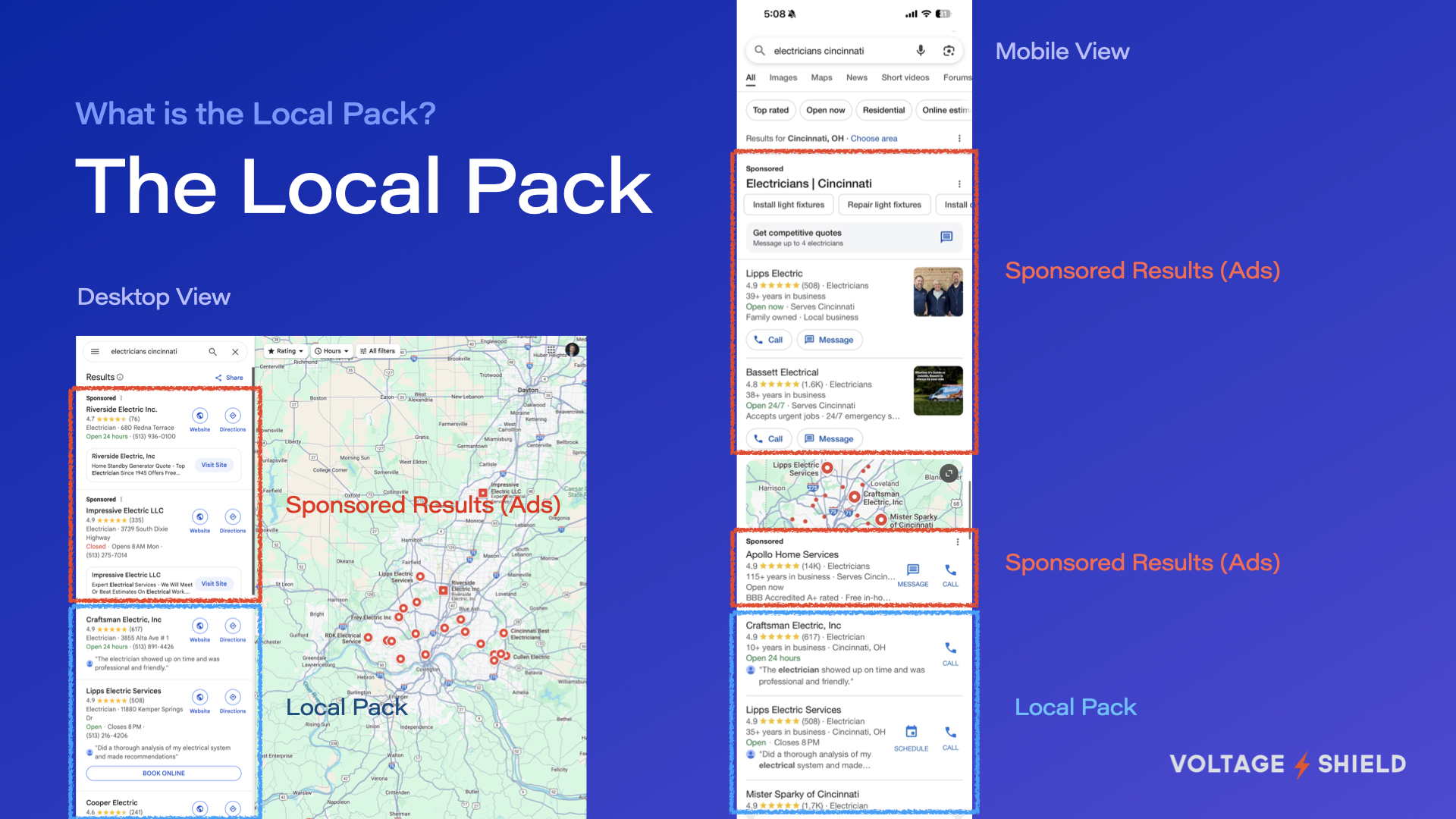Local SEO Showdown: Why One Electrician Ranks #1 and Another is #20
May 25, 2025Electrician,Local Pack,Local SEO
Do you ever wonder why your electrical business isn’t showing up high on Google’s ‘Local Pack’? Today we’re going to look at one reason why your business struggles to get noticed by Google.
First, we’re going to examine a top-ranking site on Google and compare it one that ranks near the bottom. And we’ll at some of the strengths of the top-ranking site and why it’s ranking near the top.
What Is the Local Pack?
When someone searches for a local service—like “electrician near me”—Google displays a map and a list of 3 top businesses. This is known as the “Local Pack.” It appears below paid ads and gets significantly more attention than organic results further down the page.
Here’s an example of the ‘Local Pack’ in a desktop and mobile format, for an ‘electrician dallas’ search
Why the Local Pack Matters
1. Higher Engagement
Businesses in the Local Pack see up to 120% more engagement—calls, clicks, and leads—compared to those outside it.
2. High Buyer Intent
50–75% of searchers take action within 72 hours. If you’re in the top 3, you’re in front of the most motivated prospects.
3. No Ad Spend Required
Unlike Google Ads, you don’t pay per click. It takes time and effort, but once you’re ranking, you don’t need to keep feeding the ad budget.
4. Long-Term Momentum
Your position in the Local Pack creates a flywheel effect. You keep getting leads without constantly spending more money.
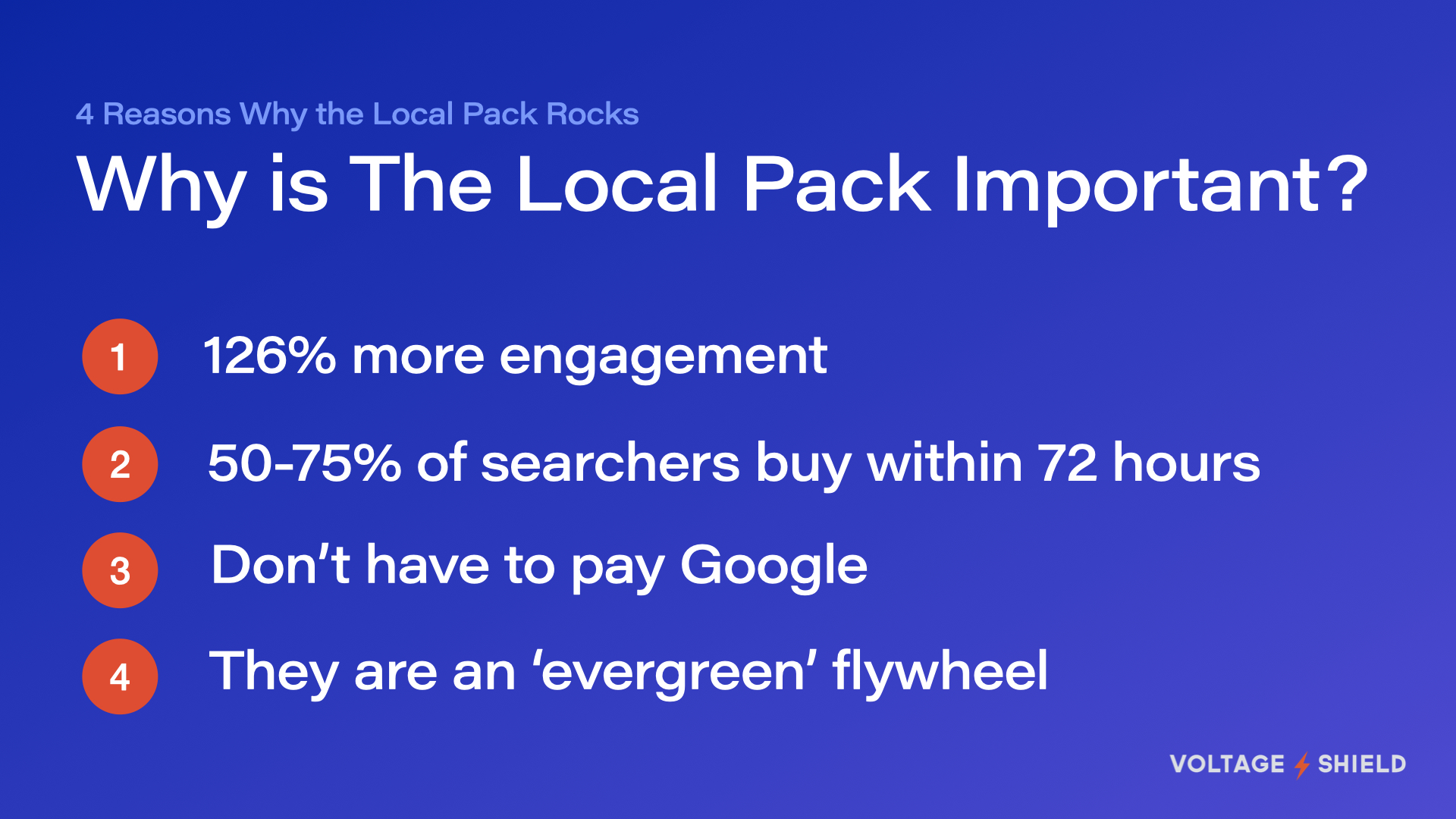 The Showdown: #1 vs #20
The Showdown: #1 vs #20
We looked at two electricians in the same city. One ranks at the top of the Local Pack. The other is buried at position 20. What’s the big difference? The #1 electrician had 18+ citations. The #20 site? Only two.
What Are Citations?
Citations are online business listings that mention your Name, Address, and Phone number (NAP). Google uses them to verify your legitimacy and improve your local SEO.
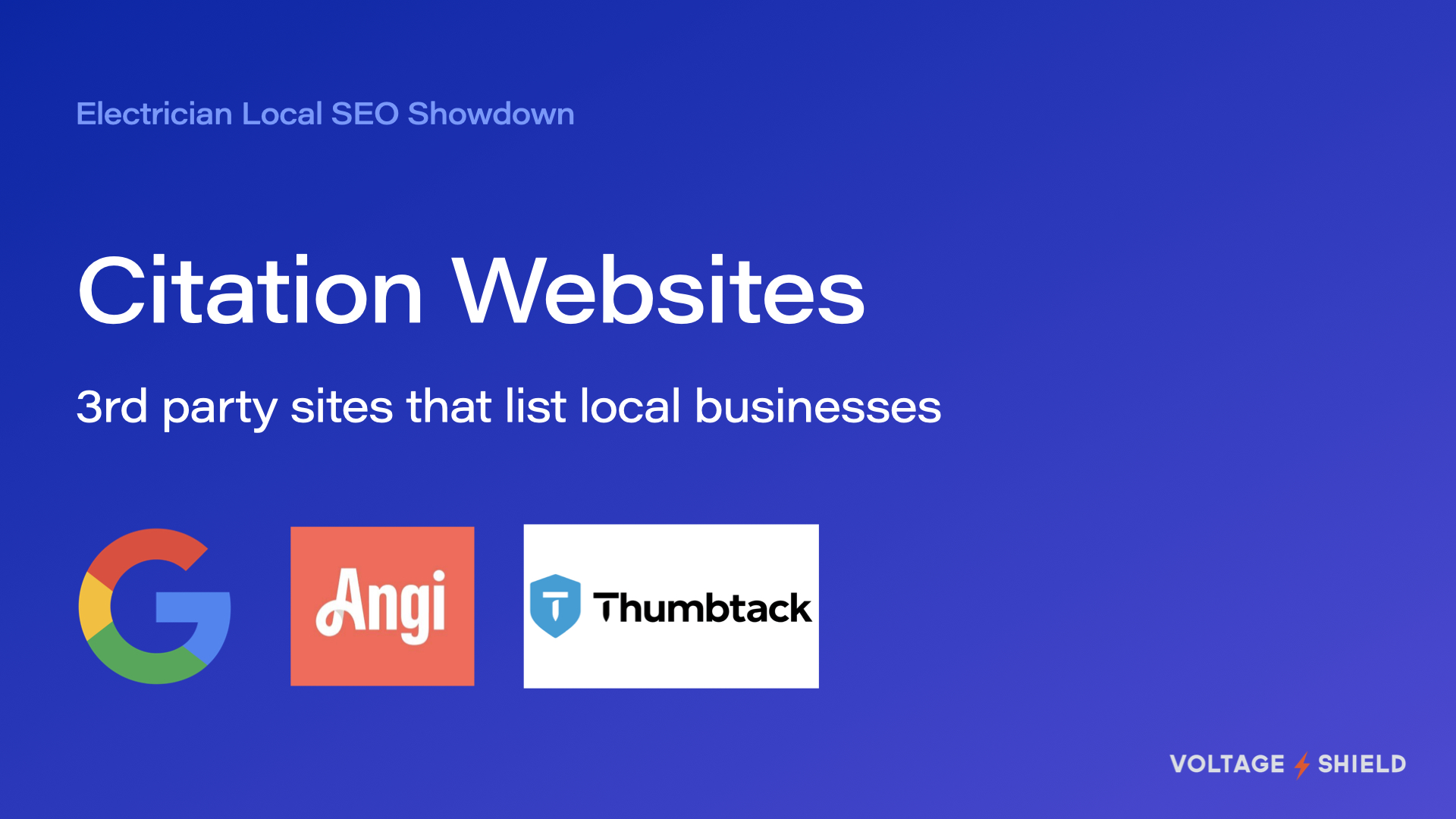 Examples of Citation Sites:
Examples of Citation Sites:
- Google Business Profile
- Apple Maps
- Yelp
There are hundreds of sites, but you only need to focus on the most relevant 40–50.
Tips for Better Citations
- Use a spreadsheet to keep your NAP info consistent
- Double-check for typos or variations in business name or address
- Prioritize industry-specific directories for electricians
Free Download: 40+ Citation Sites for Electricians
I’ve created a free PDF listing over 40 high-value citation sites specifically for electricians. Each entry includes a direct link so you can quickly set up your listings and improve your local SEO.
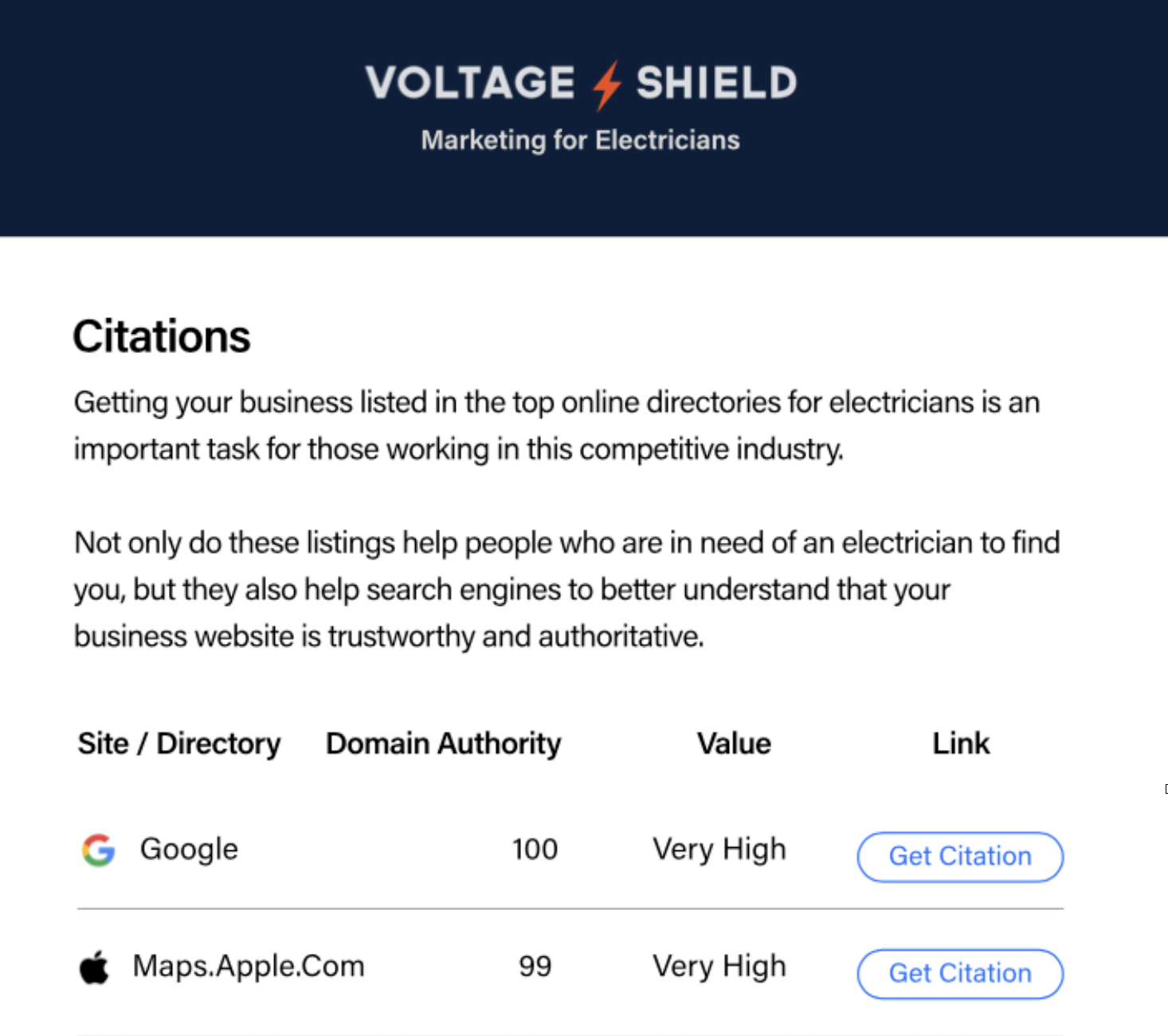 👉 Download it here: voltageshield.kit.com/citations
👉 Download it here: voltageshield.kit.com/citations
Need Help? I’ll Run a Free Report for You
If you’re not sure where your business is currently listed, send me an email and I’ll run a free citation audit for you:
Email: jon@voltageshield.com
About VoltageShield
We help electricians get found, get called, and get hired. From citation setup to full SEO strategy, we’re here to help local trades dominate search results.
Top 5 Ad Strategies for Electricians on Facebook
May 21, 2025Electrician,Paid Advertising
What Ads Are Actually Working for Electricians on Facebook?
I know electricians run ads on Facebook, they're easy to see on Facebook's Ads Library. I also know from talking to electricians that ads can often be a waste of money – especially if you are trying to run them yourselves without a solid plan or strategy in place.
In this post, I’m exploring the top five ad strategies I discovered after analyzing more than 1,000 Facebook ads run by electricians across the country.
If you’ve been struggling to get results with Facebook ads—or you're just curious what the top performers are doing—this is for you.
How I Researched Over 1,000 Electrician Ads
I used Meta’s Ad Library to explore active Facebook ads in the electrical space. If you’re not familiar with it, you can visit facebook.com/ads/library to search any keyword, business, or topic to see what ads are running now (and which have run in the past).
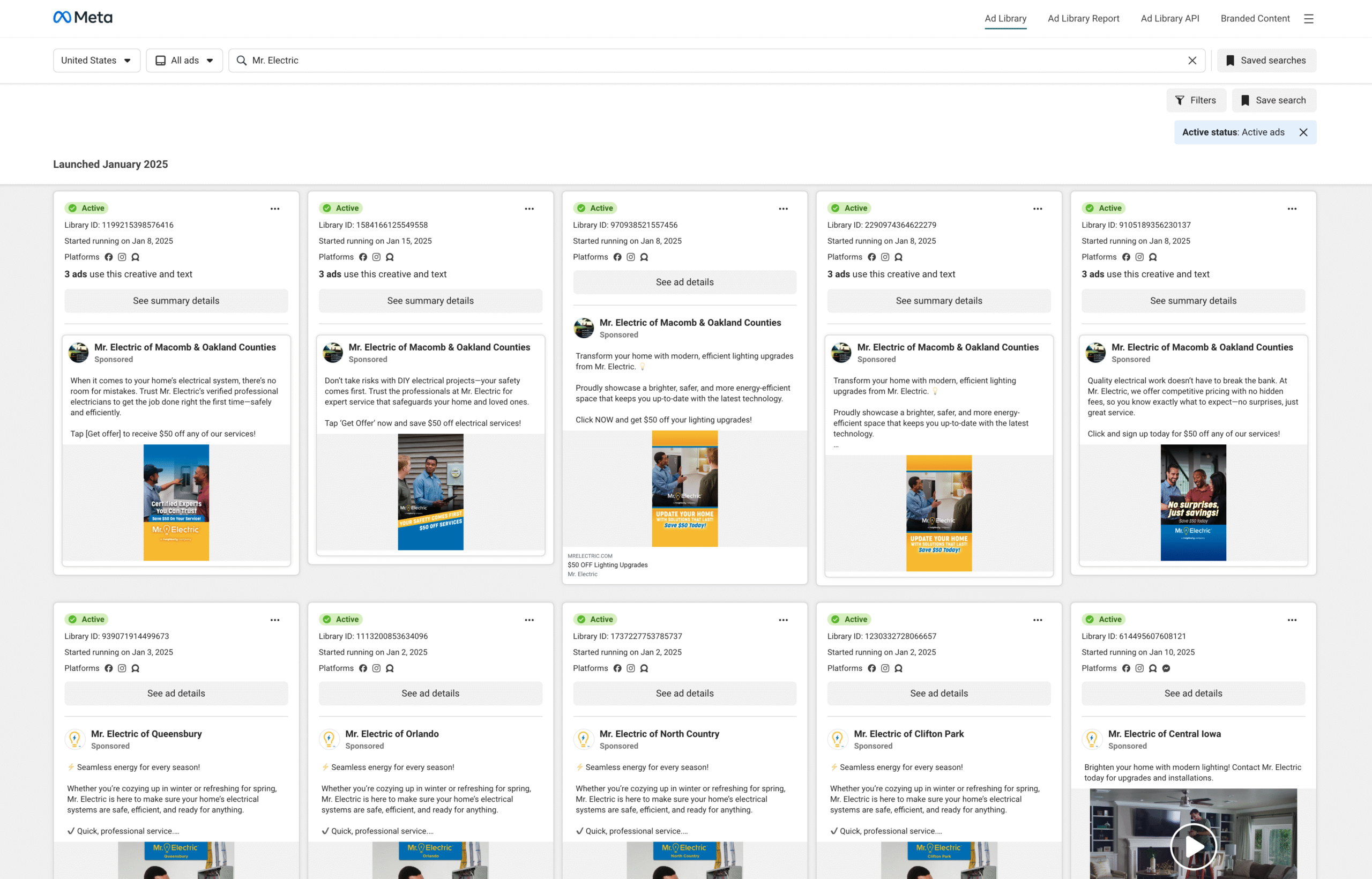
Here’s how I narrowed things down:
- I only looked at active ads that have been running for more than 30 days. If an ad is still live after 30 days, it's probably working.
- I paid close attention to ads from Mr. Electric, a large franchise that operates in most major metros and has a strong digital marketing presence.
- I also looked at dozens of independent electricians and flagged strategies I saw showing up repeatedly across multiple advertisers.
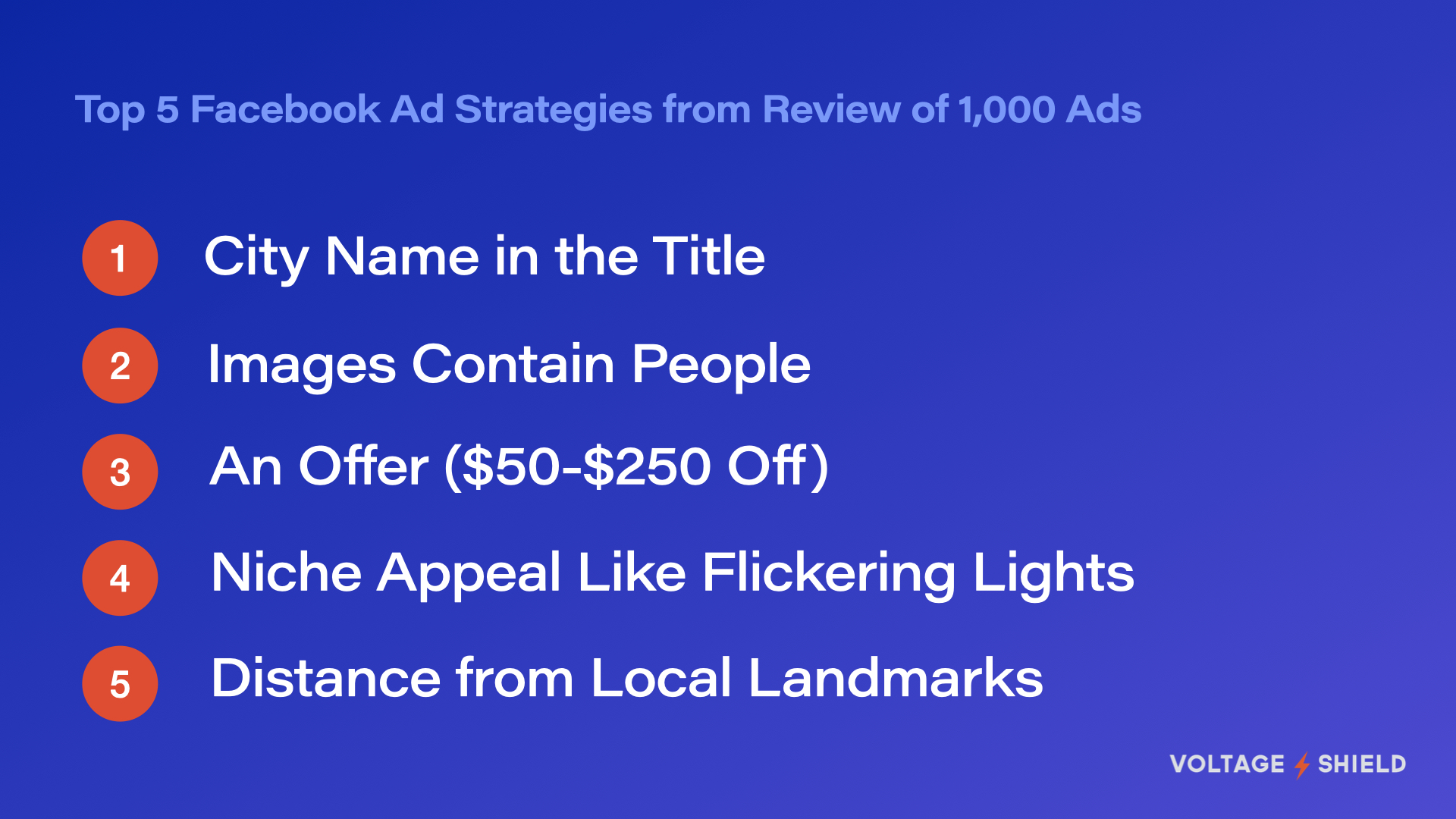 The 5 Most Effective Facebook Ad Strategies for Electricians
The 5 Most Effective Facebook Ad Strategies for Electricians
1. Include the City Name in the Headline
One of the simplest and most powerful strategies is using the city or county name right in the ad headline or page title. When people are scrolling Facebook, they won’t know you’re local unless you spell it out.
Examples:
- “Mr. Electric of Cincinnati East”
- “Snohomish County Electrical Services”
Including the location helps your ad stand out from generic competitors and builds instant relevance.
2. Use Images That Show People
It might seem obvious, but ads that include real people—especially faces—get way more attention. A face stops the scroll. A newly installed electrical panel (no matter how nice) just doesn’t.
I saw this across companies, not just Mr. Electric. The longer I browsed ads, the more I noticed that the ones with people jumped out—and the ones with just technical equipment blurred together.
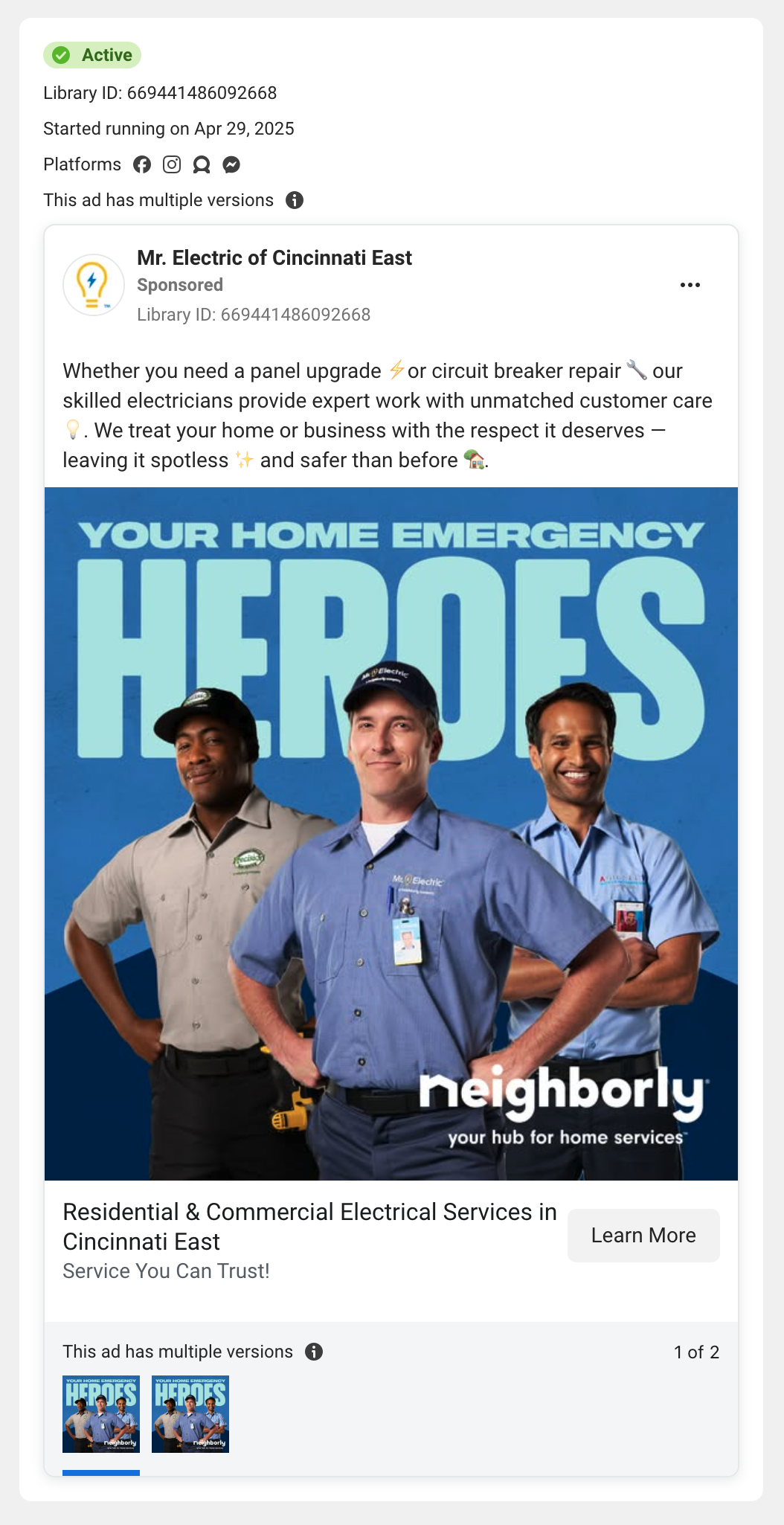 3. Make an Offer: Discounts, Financing, or Urgency
3. Make an Offer: Discounts, Financing, or Urgency
Many of the most effective ads included an offer. That could be a discount, limited-time incentive, or a financing plan.
Examples I found:
- “$250 off panel upgrades” – Mr. Electric
- “15% off kitchen rewire” – Local Utah electrician
- “Promotional financing for EV panel installs”
These types of ads create urgency and give the customer a reason to take action now—rather than scroll past.
4. Target Niche Services, Not Just “General Electrical Work”
Generic messaging like “We’re your local electrician” isn’t as effective as highlighting specific problems or services. The best-performing ads spoke directly to a very specific need.
Examples:
- “Having flickering lights? Let us diagnose the issue.”
- “Hot tub installation? Call us for safe wiring.”
- “Need a generator before hurricane season?”
The more specific the service, the more likely the ad will resonate with someone actively searching for that solution.
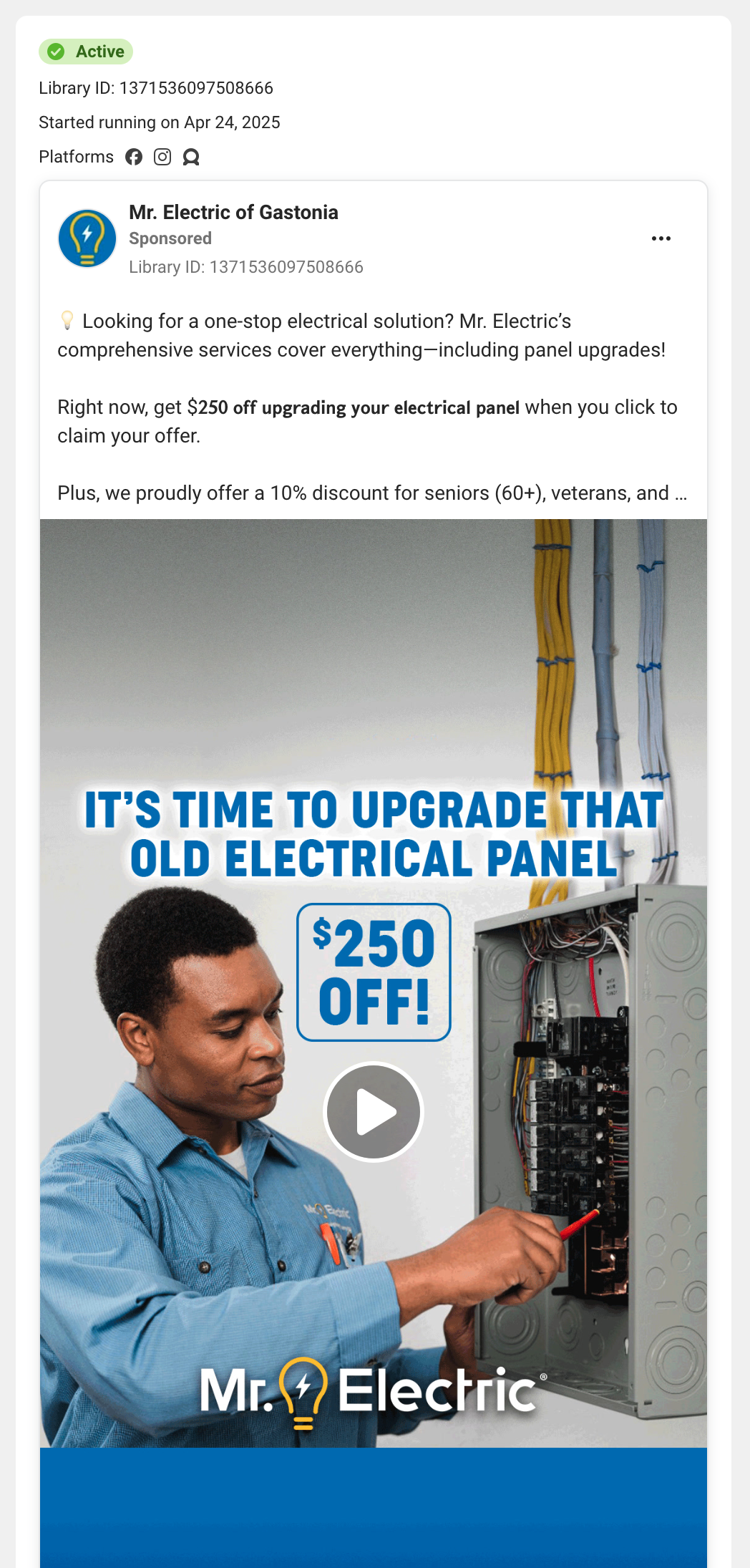 5. Mention Distance from Local Landmarks
5. Mention Distance from Local Landmarks
This was a strategy used primarily by Mr. Electric, but it’s brilliant. Ads would say things like:
- “Only 1.3 miles from Stone River Mall”
- “Just 2 miles from Hamilton Place in Chattanooga”
This kind of hyperlocal positioning makes the business feel part of the community, which builds trust and increases conversion rates. Combine this with the city name and face in the image? That’s a winning formula.
Why These Facebook Ad Strategies Work
All five of these strategies build trust, familiarity, and relevance. They speak to specific problems, show real people, make compelling offers, and localize the business in the viewer’s mind. That’s how you create the “know, like, and trust” factor that gets people to click.
Final Thoughts
If you’re an electrician trying to grow your business, these Facebook ad strategies can help you stand out and get more qualified leads.
I’m Jon from Voltage Shield, and I specialize in helping electricians get found, get called, and get hired. If you want help with your marketing—or just want to talk shop—feel free to reach out.
3 Usability Mistakes That Are Costing Electricians Calls (And How to Fix Them)
May 20, 2025Electric Business,Site Audit
If you’re an electrician, here’s a hard truth: most of your customers aren’t judging you based on your wiring skills—they’re judging you based on your marketing. And while there’s many paths they can take to discover your business, today we’re going to focus on your website.
Your website is a key piece of the overall marketing puzzle. And if your website has usability problems? You’re probably losing calls, jobs, and revenue.
Today, I want to walk through the top three usability issues I see on electrician websites and show you how to fix them fast.
1. Your Phone Number Is Hidden
This is the most common—and most frustrating—mistake I see. Your customer is ready to hire someone, and your number is buried in the footer, behind a form — or behind a button.
The ‘contact us’ button leads to weird states like this:
Above, I’m browsing on my desktop – when I click a ‘contact us’ button, instead of giving me a contact form or phone number, the site wants to open Facetime. Not a great customer experience – I never, ever want to open Facetime on my computer to speak to someone I don’t know, and I bet most consumers feel the same way. It’s hard enough to get people to call a regular phone number.
What to do instead:
- Put your phone number at the very top of the page
- Include it in the footer of every page
- The best sites include it throughout
- Contact us forms can be good
- Chat windows can also be effective
- Make it clickable on mobile devices
⚠️ Remember: If someone can’t find a phone number fast, they’ll just call your competitor.
2. Your Site Loads Too Slowly
Slow websites cost you business. Customers won’t wait more than a few seconds, and Google will push you down in local rankings if your page speed is poor.
I used Google’s PageSpeed Insights to test electrician sites. This is a helpful (and free!) tool provided by Google to help marketers and site owners diagnose and fix performance issues.
PageSpeed Insights
Watch these metrics:
- First Contentful Paint: under 3 seconds
- Largest Contentful Paint: under 6 seconds
- Image sizes: large files slow down loading
💡 Pro Tip: Test your site on a slow 4G connection to see what your customers experience.
3. Your Photos Are Boring (or Worse—Stock)
Photos are (one of) the first thing customers notice. If your site has no people, no real projects, or uses generic stock images, it won’t build trust.
Remember that people do business with those that they ‘know, like and trust.’ You want your website to inform (know), show smiling people (like) and show reviews, credentials, license numbers and years in business (trust).
I’m not against stock photography on principle, it’s just for your website – small, local business trying to build trust in the community – stock photography is inappropriate, especially when your iPhone has a camera with outputs that rival professional setups.
We all know stock photography when we see it. For example, the classic ‘laughing business people’

These aren’t terrible images, but they won’t get you to ‘know, like and trust’ with your audience.
A word on AI images – they are getting much, much better, but unless you are a visual person and a power user of AI image generating software, I’d recommend staying away from them. They tend to create images that are in the ‘uncanny valley’ – too realistic to be a hand-drawn rendering, but obviously computer-rendered that just feels ‘off’.
Here’s what works:
- Photos of your team — show faces, uniforms, and people on the job
- Branded vehicles — prove you’re legit
- Real customer interactions — no stock images!
Compare the above list to the website of Mr. Electric of Dallas. Their homepage has photos of their techs, their vans, and their work—real people, real branding. Look over the website, and it’s no surprise they rank at the top of Google for keywords like ‘electricians dallas’.
Quick Recap: Fix These Fast
If you want more leads from your website, fix these issues first:
- Put your phone number at the top
Make it easy to call you—no extra clicks required. - Speed up your site
Use PageSpeed Insights to check performance and get recommendations. - Use real photos
Show real people doing real work. Build trust at a glance.
Let’s Make Your Website Work for You
Your website should be more than a digital business card. It should help you get found, get called, and get hired.
If that’s not happening, it’s time to make some changes—and we can help.
I’m Jon from VoltageShield. We do marketing for electricians who want to grow their business, show up in search, and get more high-value leads.
What Electricians Can Learn from Mr. Electric of Dallas (and Why They’re Winning Local Search)
May 18, 2025Electric Business,Electrician,Site Audit
Last week, we looked at a few electrician websites that had big opportunities to improve their local search presence. This week, we’re flipping it—looking at a company that’s doing it right, so we can break down what’s working and maybe steal a few good ideas.
Why Local Search Matters
When people search “electricians near me” or “electrician Dallas,” they’re usually shown a group of local results at the top of Google—this is called the Local Pack. Getting your business listed here can lead to 126% more engagement than not being listed at all. It’s prime real estate, and it’s where small businesses should be focused.
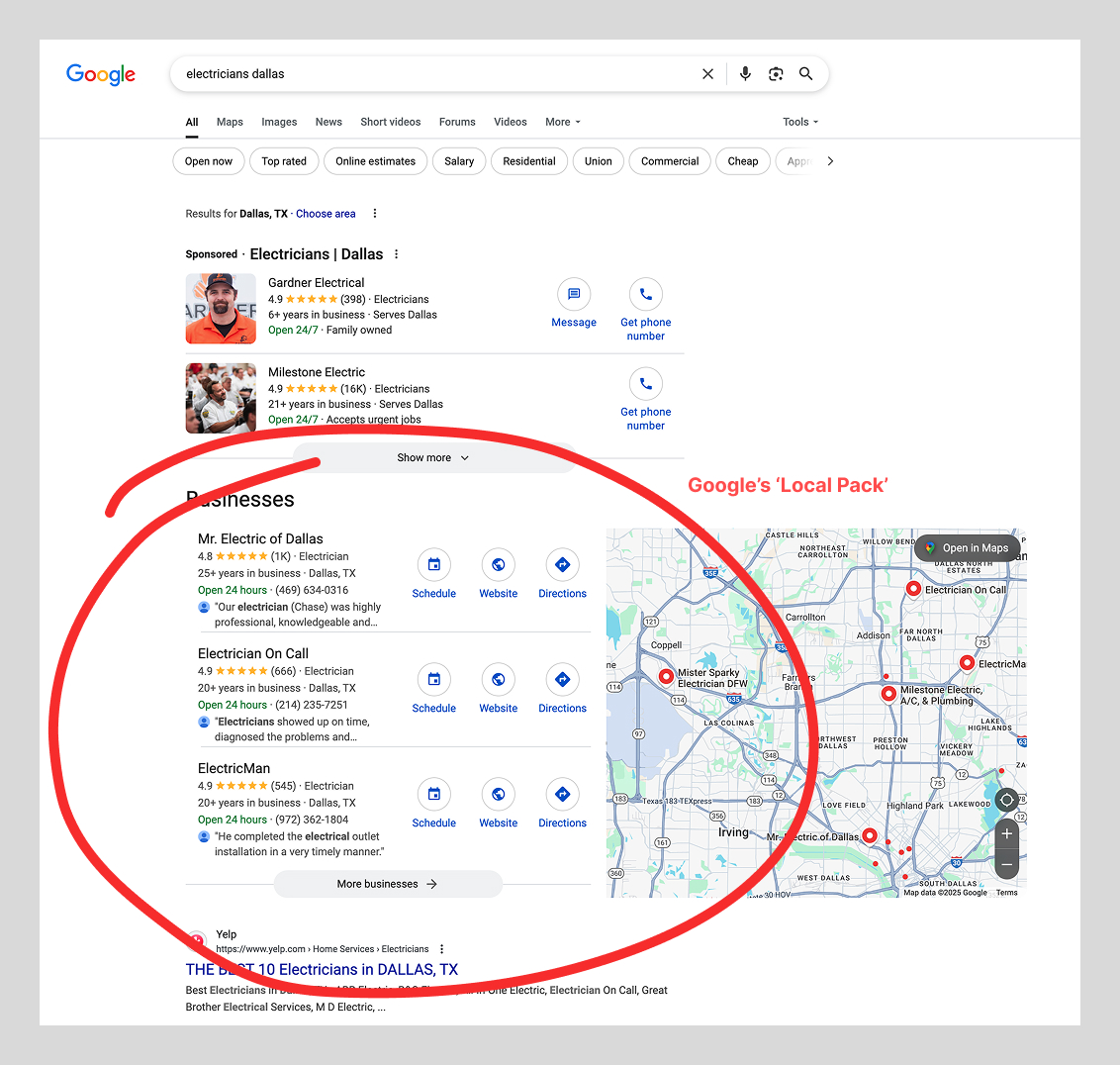 Today, we’re looking at Mr. Electric of Dallas, one of the top performers in the Dallas electrician market.
Today, we’re looking at Mr. Electric of Dallas, one of the top performers in the Dallas electrician market.
A Look at Their Google Business Profile
- Primary category set to “Electrician”
- Online booking enabled
- Phone number and directions clearly displayed
- Service areas filled in (Dallas)
- Over 160 high-quality photos uploaded
- Consistent, high-rated reviews
If you’re not regularly adding photos and keeping your profile up to date, you’re missing an easy win.
Their Website: What They’re Doing Well
Check out Mr. Electric of Dallas’ website, there’s lots to learn from.
- Clear headline + “Call Now” button
- Easy online scheduling
- They mention Dallas and neighborhoods served
- Well-organized list of services
- Photos of real technicians and branded vans
- Phone number / contact call-to-action shown multiple times
- Strong trust-building section (upfront pricing, licensed/insured, no overtime fees)
Most electricians bury this stuff—Mr. Electric puts it front and center.
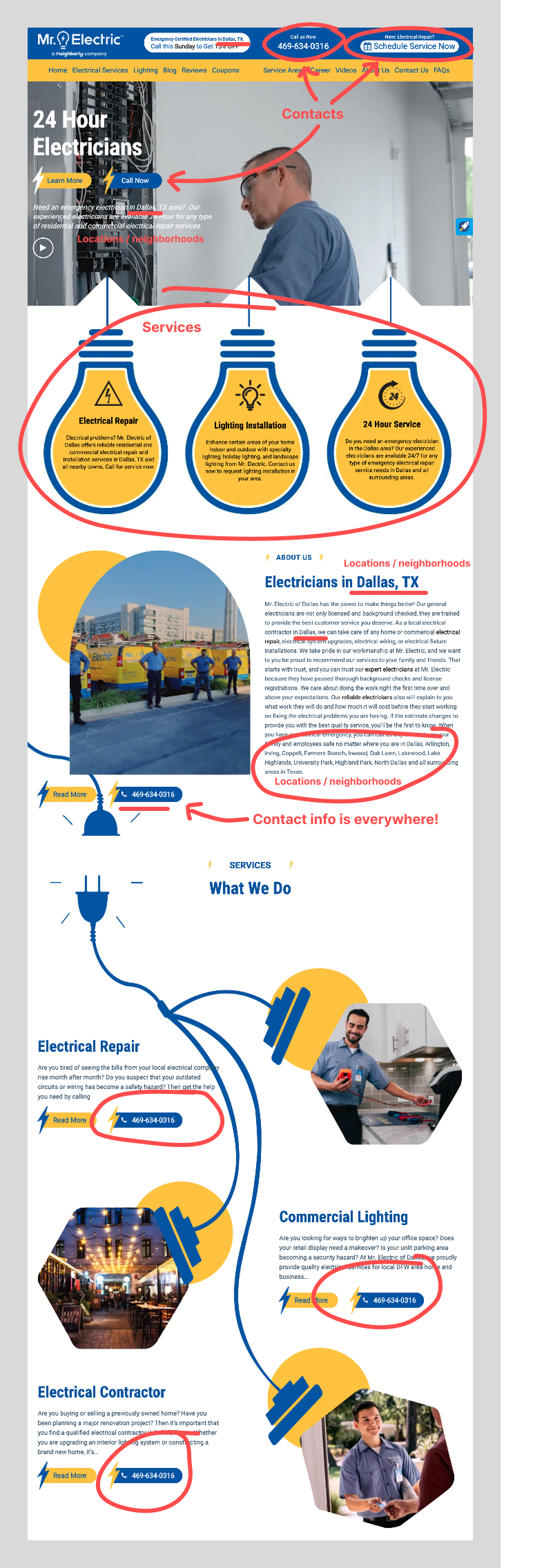
What the Data Says (SEO Breakdown)
- #2 for “electrician in Dallas Texas”
- #7 for “Dallas electrician”
- #1 for branded searches like “Mr. Electric of Dallas”

Their homepage ranks for the bulk of their important keywords—proof that a long, content-rich homepage works.
SEO Fundamentals They’ve Nailed:
- Meta titles & descriptions
- Image alt text
- Proper heading structure
- Canonical tag setup
- Clean internal linking
Local Search Visibility
Using a local rank tracker grid, we checked how they show up across a 10-mile radius in Dallas. The results?
- #1 in many of the areas closest to their location
- Top 3 visibility in outlying areas
Competing against hundreds of electricians—and still dominating.
Why They’re Winning: Backlinks, Citations & Reviews
Backlinks
They have fewer backlinks than some competitors (4,000 vs. 141,000) yet still outrank them. Why? Because they’ve built a strong local presence, not just a pile of links. At the local level, quality of links matter far more than than the quantity.
Local Citations
They’re listed on many of the major directories:
- Yelp
- MapQuest
- Yellow Pages
- And many, many more
They’re missing Bing and Apple Maps—easy wins if they fix that.
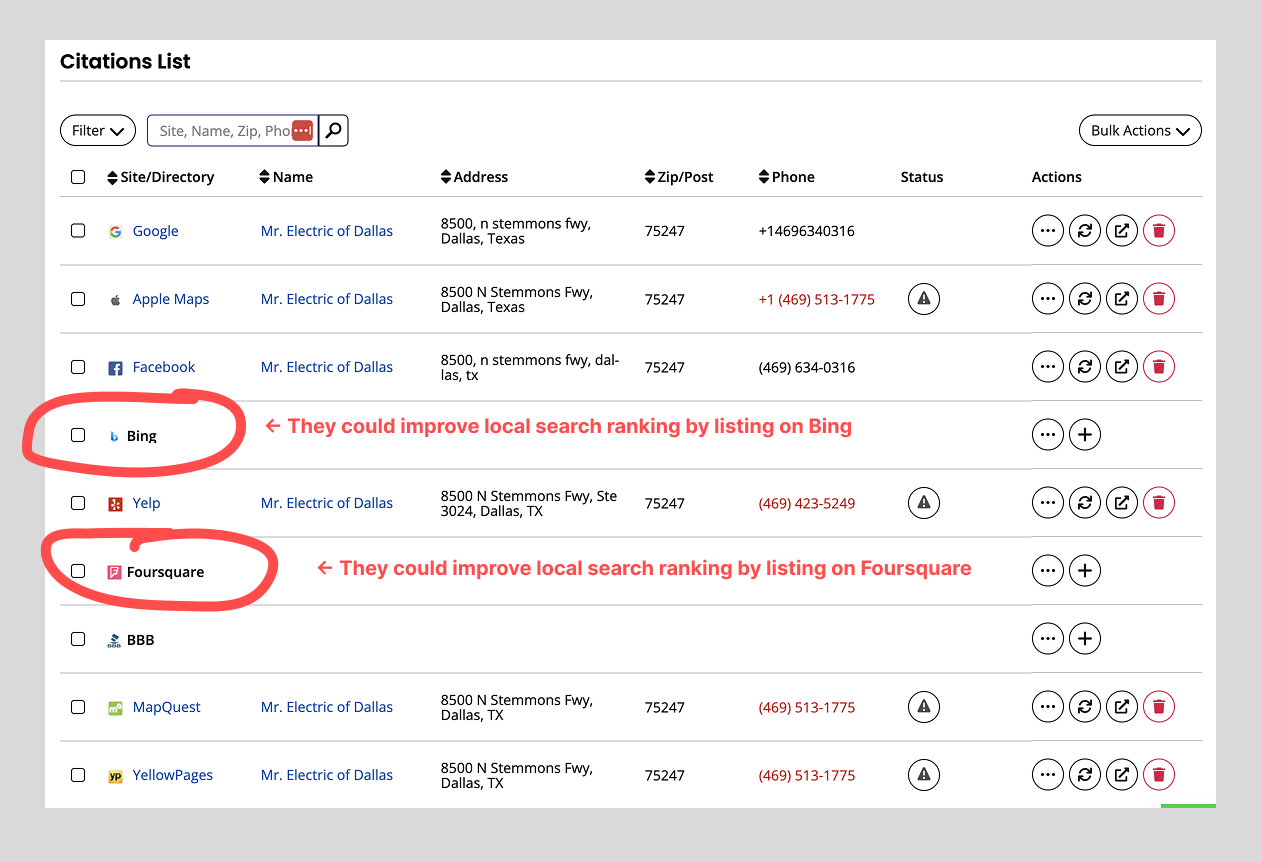 NAP Consistency
NAP Consistency
They do have some issues with NAP (Name, Address, Phone) consistency—three different phone numbers were found. Fixing this would help tighten their rankings even further.
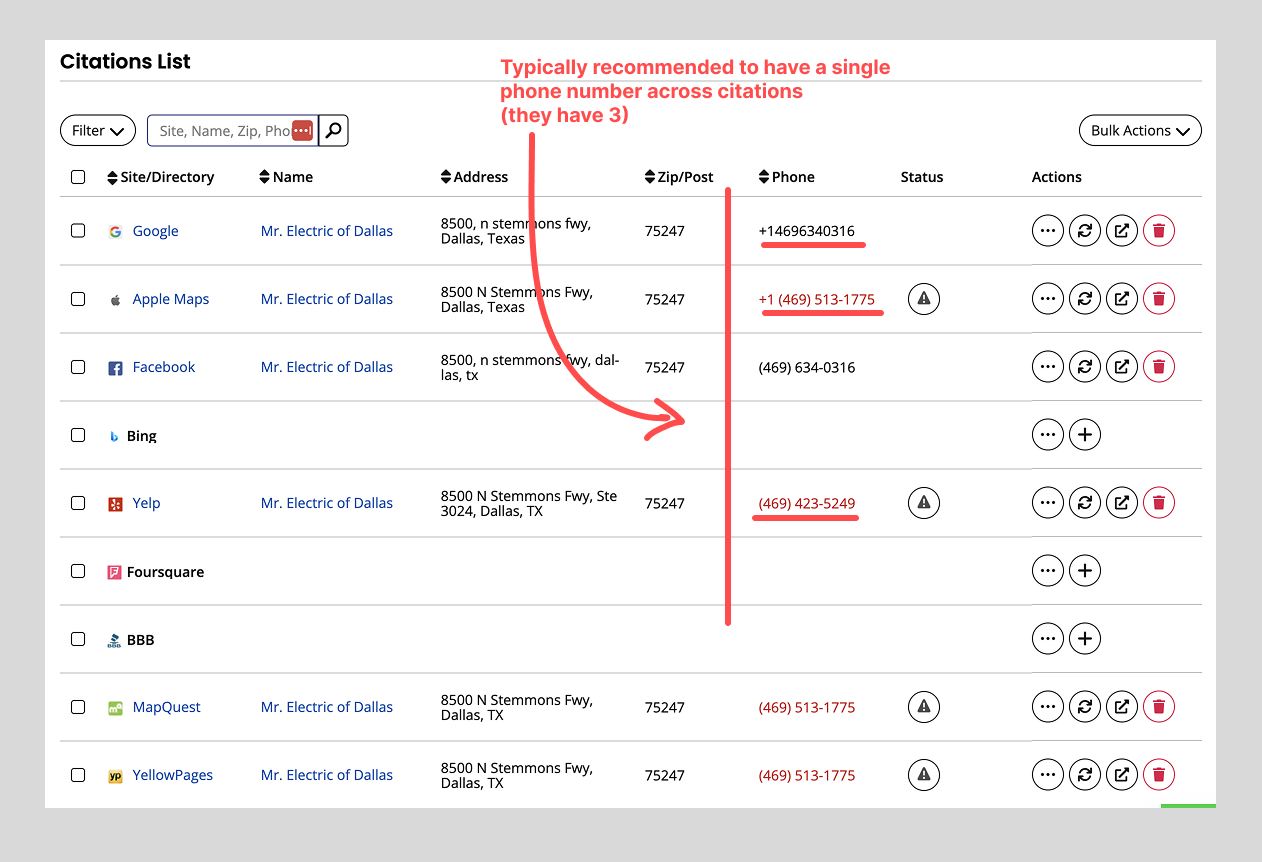 Reviews
Reviews
- Healthy mix of 1–5 star reviews
- Regular review activity (every 2–3 weeks)
- Organic, real feedback—not review-gated
This is exactly what Google wants to see.
Final Takeaways for Electricians
If you’re an electrician trying to grow your business, here’s what you can take away from Mr. Electric of Dallas:
- Fill out your Google Business Profile completely
- Post photos regularly
- Design a homepage that builds trust (with lots of content) and gets calls (with lots of phone numbers and contact forms)
- Get listed in as many reputable directories as possible
- Keep your NAP (name, address, phone number) consistent across your digital presence
- Collect new reviews every few weeks and don’t worry if there’s one or two negative reviews that occasionally surface
How Electricians Can Get Found on Google — and Get the Call
May 7, 2025Electric Business,Electrician,Google Business Profile,Reviews
If you want your business to perform better in local search, and you’re looking for relatively quick results, there’s a few things you can do to move the needle in weeks (not months).
Claudia Tomina wrote an awesome round up of 11 aspects of ranking for local search – and I want to expand on some of her points in her article.
Aligning Your Google Business Profile’s Primary Category to Search Volume
The first point is about aligning your Electric Business’ primary category with what people are searching – what’s called search intent. This is a change that can be made easily – and it should also be carefully considered.
It’s a big deal, and it makes a difference on how you show up in local search.
Electrician Near Me – Keyword Searches
A prime example of intent is a search like ‘Electrician Near Me’ – Google knows that this person is looking for an Electrician, and Google knows through experience that these searches are high-converting. Indeed, 76% of these searches will make a call or website visit to one of the companies the in the Local Pack (more on this in a bit). About the same number will end up making a purchase within 72 hours.
You absolutely want your Electric business to come up for these types of searches. And the way you do that is by being smart about your category.
To Pick the Right Category, Research What Your Customers Are Searching on Google
There’s no mystery for the primary category. Unless your business is a * highly * specialized and is primarily going after something like Generator Installs, then you want Electrician to be your primary category.
Pro Tip: Research search volume for keywords related to your business before deciding on your primary category. The right choice could help you dominate the most relevant search results.
Claudia Tomina
I used AHREFs SEO tool to research what people are searching for the word ‘Electrician’ and here’s the list I found:
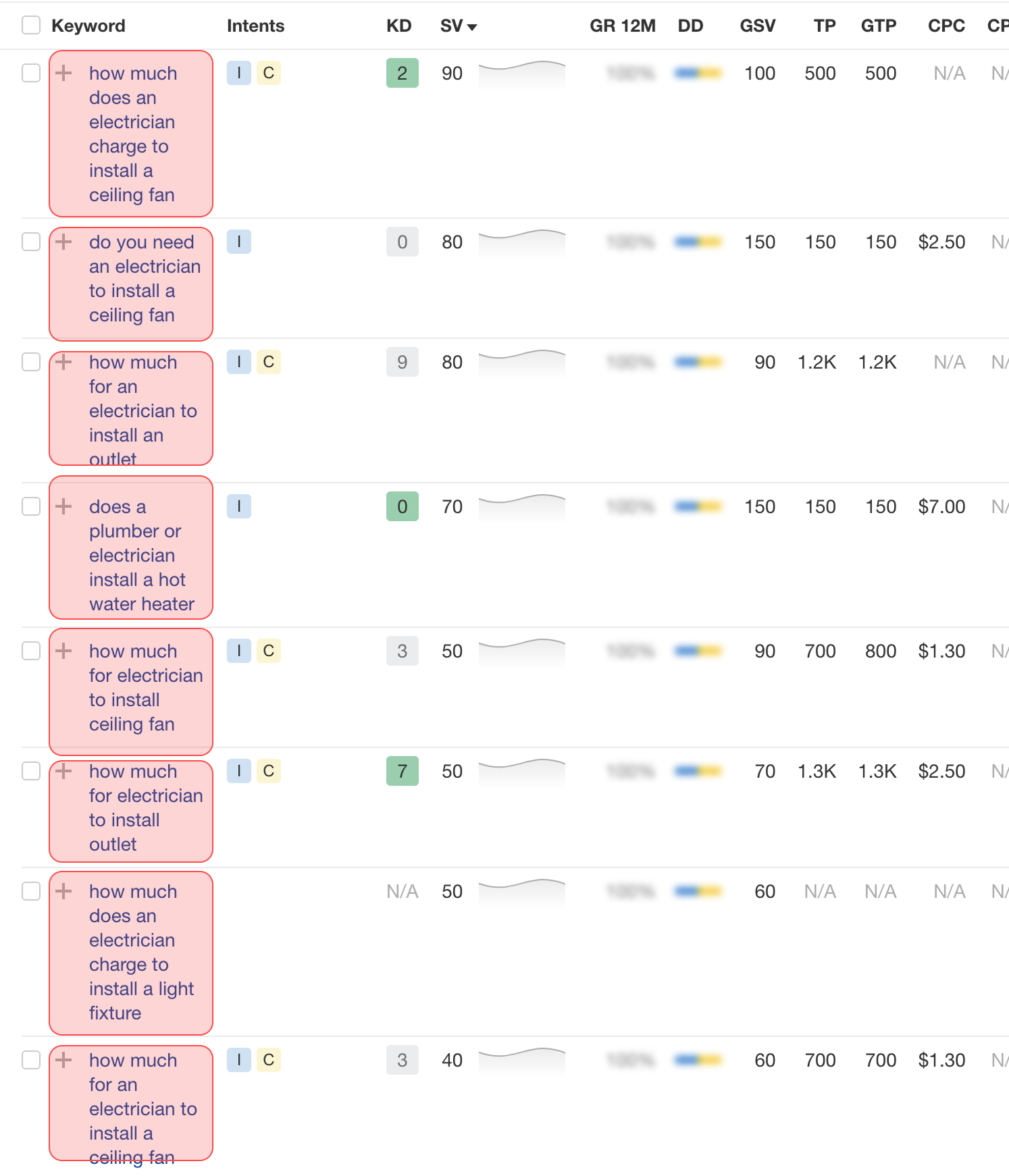
So if we’re looking for ideas about secondary categories, we might think about words like electrical outlet, ceiling fan, hot water heater, light fixture etc. I don’t want to stop there, however.
I want to look at my competition, especially the competition that comes up on Google’s ‘Local Pack’. These competitors are enjoying the bump in traffic, engagement and calls that result from inclusion in Google’s Local Pack.
Find Which Keywords Are Your Competitors Are Using
I like looking at what other companies are using for keywords, in particular the companies that are consistently showing up in Google’s Map Pack. If you don’t know what that is, check out this article about Google’s Map Pack.
Here’s an example of a primary category:

A search for ‘Electrician Austin’ brings up a company called DC Electric. Their primary category is displayed prominently at the top of the individual search result.
In the next example, we’ll be able to see what categories DC Electric choose as their secondary via a Local SEO Plugin called PlePer:
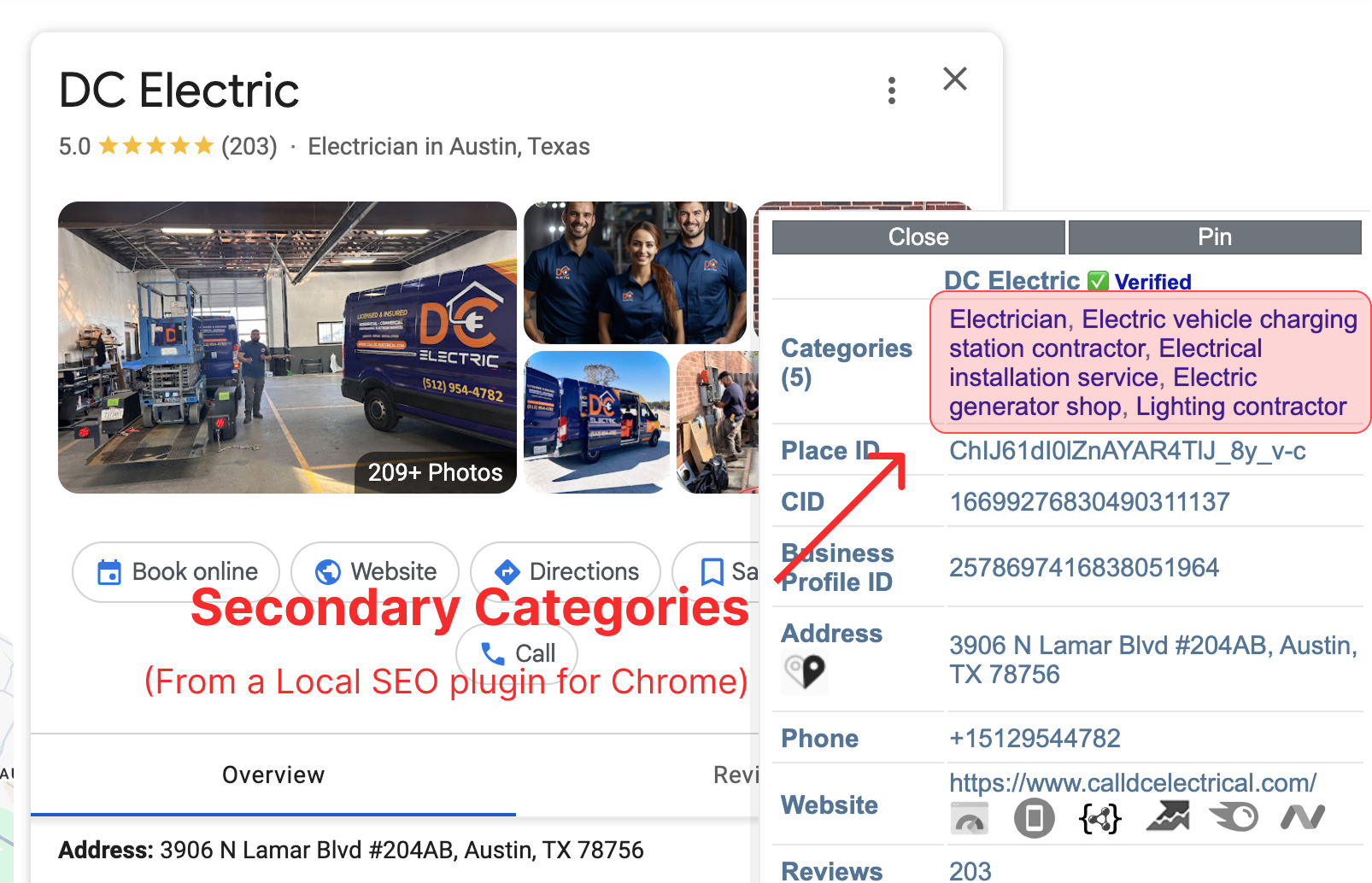
Here are the secondary keywords that made the list for DC Electric:
- Electric vehicle charging station contractor
- Electrical installation service
- Electric generator shop
- Lighting contractor
Those charging station and generator installs are high-profit jobs, so it’s great to see that DC Electric is advertising against those terms.
Lighting contractor makes perfect sense as well – your customers might have the intent to find an electrician, but because of the nature of their problem, they might be searching slightly different terms (such as Lighting Contractor). So adding secondary categories for this (as long as they can support the service) is an excellent idea.
Combine the search volume research with the research on local competitors and you’ve got the right information to decide what categories to choose on your Google Business Profile.

